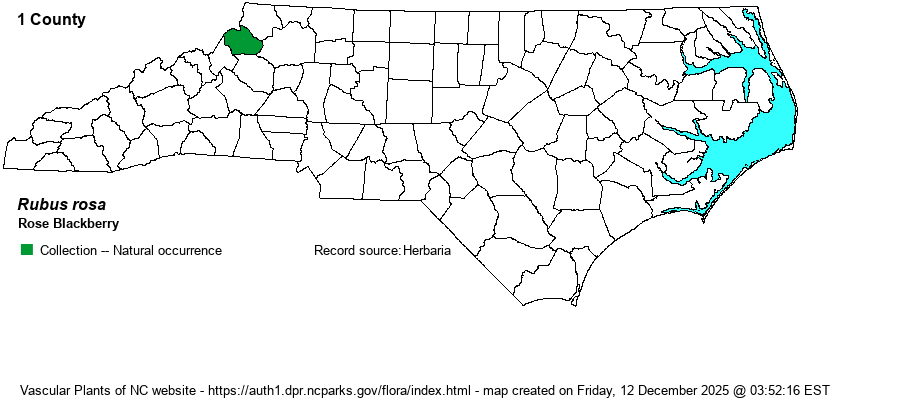| Author | Bailey | |
| Distribution | Specimens (at Carnegie) for Watauga County only, in 1966; as with several other "new" Rubus species, all specimens for NC were collected by H.A. Davis (who seemingly was the only person back then who knew Rubus species identifications). Thus, this species is so very poorly known in the state that whether it is truly rare (or even extirpated) is not known. However, this is a Northern species, known south only to WV, but not yet collected in VA; thus, it may well be (or have been) disjunct to the northern mountains of NC.
"NB to MN, south to NY, WV, and e. KS" (Weakley 2024). | |
| Abundance | Presumably very rare, if still present. The species is not in the NC NHP database -- perhaps as Weakley (2024) has newly included this taxon as a good species(?) -- and thus the website editors suggest a State Rank of S1? for now. | |
| Habitat | "Fields, thickets, old pastures" (Weakley 2024). | |
| Phenology | Flowers and fruits in May and June. | |
| Identification | From the Minnesota Wildflowers website: "Rose Blackberry is identified by the combination of: abundant glandular hairs on sepals, flower stalks, leaf stalks and the upper portion of stems; prickles are broad-based, straight to slightly curved, 6 to 8 mm long; lower leaf surface is velvety hairy; the flower cluster is either a raceme or compound corymb with up to 25 flowers. Canes can reach 8 feet in length and typically lean or arch over but are not known to root at the tips. Primocane leaves mostly have 5 leaflets, sometimes 3 on the lower stem, the terminal leaflet is notably broad, has a short extended tip (acuminate) and is rounded to heart-shaped at the base.
"In many references Rubus rosa is lumped in with R. allegheniensis .... R. rosa is most easily recognized by the large, broad terminal leaflet, at least 3/4 as wide as long, but its flowers and fruits tend to be larger than others as well. The compound corymb flower cluster is another distinction, though, per Welby Smith's book, this has only been seen in the north-central part of the state and not elsewhere (our photos of that came from Pine County). The terminal leaflet on ... R. allegheniensis is more narrowly egg-shaped or elliptic, about half to 2/3 as wide as long, and the raceme on R. allegheniensis is a narrow, elongated raceme." | |
| Taxonomic Comments | Weakley (2024) lists this as a good species, presumably pulled out from R. allegheniensis.
| |
| Other Common Name(s) | None | |
| State Rank | [S1?] | |
| Global Rank | GNA | |
| State Status | | |
| US Status | | |
| USACE-agcp | | |
| USACE-emp | | |

